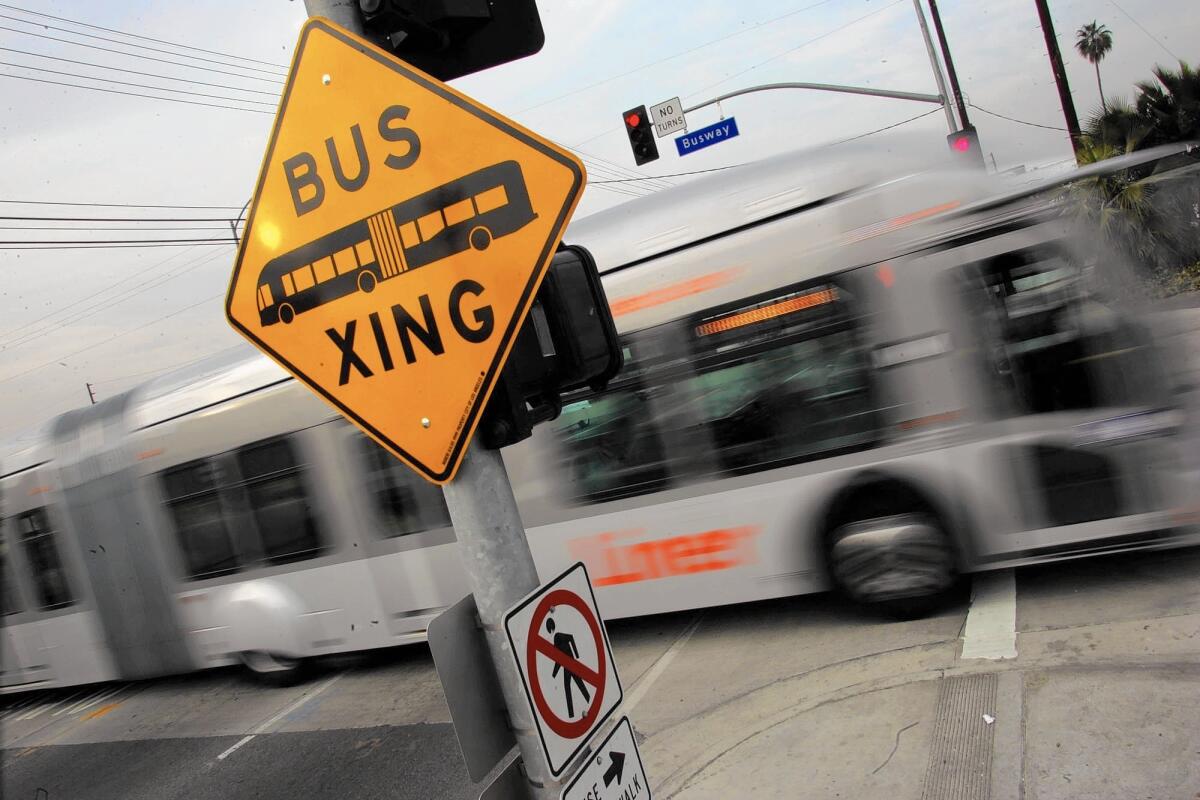California Commute: Metro to study converting busy Orange Line busway to a rail line

A generation ago, Los Angeles County officials envisioned a subway that would gather up commuters across the San Fernando Valley and whisk them to downtown Los Angeles, avoiding the infamous traffic of the 101 Freeway.
But after years of funding, design and political battles, the Metropolitan Transportation Authority scuttled plans for a rail line — either above or below ground — and opted for a dedicated 18-mile busway that could be built relatively quickly and cheaply on an old streetcar right-of-way.
The Orange Line has since become the busiest bus route in the Valley, carrying about 30,000 riders a day between Chatsworth, Warner Center and North Hollywood. That’s a sign, advocates say, that it’s finally time for the busway to become a rail line.
Such a conversion — including buying trains, building stations and laying track — would cost $1.2 billion to $1.7 billion and take two to three years to complete, according to a new report prepared for Metro and reviewed by The Times.
Metro’s board of directors is scheduled to review the analysis this week.
Some elected officials and advocates argue the county’s rail-building boom over the last three decades has shortchanged the Valley, home to nearly 20% of county residents. The sprawling and largely built-out suburb, with its own large employment and commercial centers, has just two of Metro’s 80 rail stations.
None of the 37 miles of rail Metro currently plans to build in the next decade would be north of the 101 Freeway.
When the Orange Line was built, its bridges were engineered to one day accommodate trains. With that sort of infrastructure in place, along with existing station parking lots, drainage and bikeways, the cost of converting the line to rail has been reduced 25%, the report said.
But the analysis also notes there are other alternatives to increase the line’s capacity. Those include buying more or larger buses and adding overpasses at the busway’s busiest intersections. Currently, long, articulated buses run in their own transit way, but in some locations they still can be required to stop for traffic lights.
Upgrading the bus service on the line would cost up to $350 million, less than a third of the cost of replacing it with rail, according to the MTA analysis.
Either change could lead to at least a 10% increase in ridership, the report estimated. But it concluded a rail line would be slightly faster, shaving about 15 minutes off a cross-Valley trip, compared with a 10- to 12-minute travel time reduction with improved bus service.
How any Orange Line upgrade would be funded isn’t clear. Money for such a project was not included in Measure R, the half-cent sales tax for transportation projects passed by Los Angeles County voters in 2008. That measure has provided local financing for the bulk of the county’s recent rail construction, and helped attract matching state and federal dollars.
Political observers say that upgrading the Orange Line, particularly to rail, could encourage Valley voters to support another sales tax ballot measure.
Metro plans either to seek voter approval next year for a proposal that could add a new tax for transportation — raising the overall county sales tax rate to 9.5% — or extend Measure R beyond its 2039 expiration date. The latter approach would allow officials to borrow billions more for new transit construction in coming years and repay it with sales taxes to be collected decades from now. Any tax increase would need the approval of a super-majority of more than 66% of voters.
The recent MTA report also examined the cost of extending the Orange Line bus route to Pasadena. That project, estimated at $130 million to $230 million, could include adding bus ramps linking to the 134 Freeway’s carpool lanes and building stations in Burbank and Glendale. That extension could increase daily boarding by up to 30,000, the report said.
Building light rail along the extended corridor, from Warner Center to Montclair, could cost $4.6 billion to $8 billion and would require two hours to travel from end to end, the report said.
Twitter: @laura_nelson
Have an idea, gripe or question? Times staff writers Laura J. Nelson and Dan Weikel write California Commute and are looking for leads. Please send them along.
More to Read
Sign up for Essential California
The most important California stories and recommendations in your inbox every morning.
You may occasionally receive promotional content from the Los Angeles Times.











